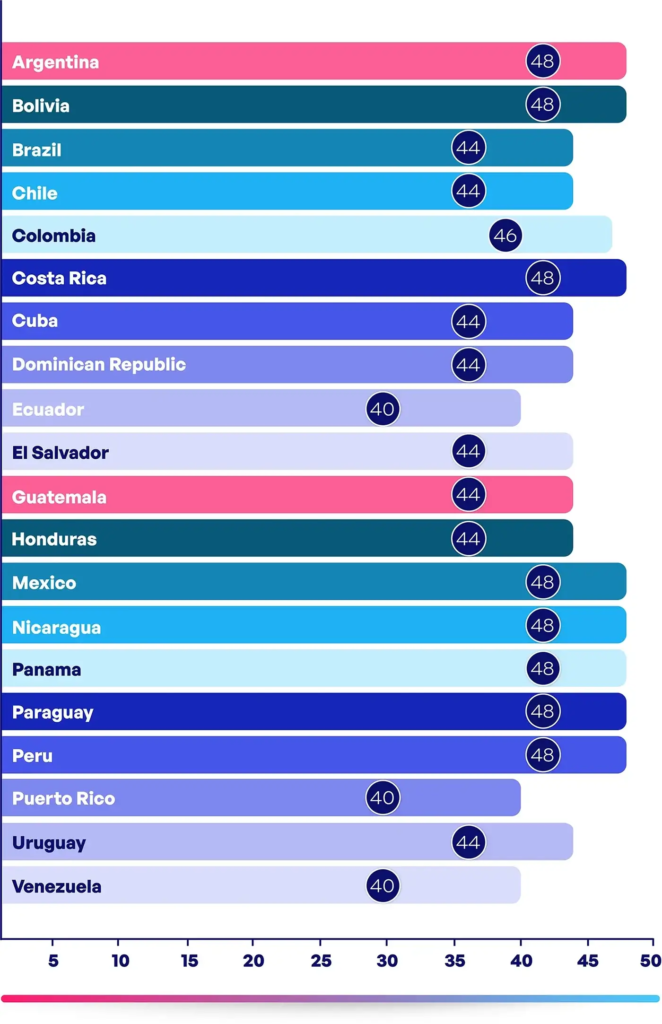The working hours in Latin America typically range from 40 to 48 total hours per week. It varies from country to country, especially when it comes to specific norms such as maximum hours per day, paid overtime, and lunch breaks.
The average work hours of a country is an important aspect of labor regulation to consider when planning to enter a new market. Adapting to these norms ensures better alignment with employees’ work habits and prevents burnout.
Some countries may have lower standard working hours and recurrently require overtime payments for extra work. Additionally, respecting local cultural norms on work-life balance can improve job satisfaction, reduce turnover, and strengthen employer branding in the region.
Maximum working hours in Latin America

Although the maximum legal working hours in Latin America extend up to 48 hours per week, workers are hired for shorter workweek frequently. In fact, this is also a global tendency.
The International Labor Organization recommends that countries restrain normal hours of work to 40 hours per week, and even overtime should be considered an exception. They argue this practice can preserve worker’s productivity and overall health.
Currently, there is plenty of discussion regarding this subject in Latin America. So, here’s an overview of what to know from each country:
Overview by country
Argentina
The standard workweek is 44 hours, with a maximum of 8 hours daily. Overtime is limited to 3 hours daily, 30 hours per month, and paid at a premium.
Bolivia
The standard workweek is 48 hours, with a maximum of 8 hours daily. Overtime is paid at a premium.
Brazil
The standard workweek is 44 hours, with a maximum of 8 hours daily. Overtime is limited to 2 hours daily, and it’s paid at a premium.
In 2024, a proposal was presented by Representative Erika Hilton to reduce weekly work hours, prohibit the six-day working week, and suggest a gradual four-day workweek. It has since gained momentum in Congress and popular media, but it hasn’t become an official measure.
Chile
The official workweek is 44 hours. Any work beyond the standard hours daily or weekly is seen as overtime and must be paid at a premium.
Since 2023, the country has been implementing a five-year plan to cut its working week from 45 to 40 hours. The reduction must be completed by 2028. Companies have been encouraged to gradually reduce their working hours in Chile year by year.
Colombia
The standard workweek is 46 hours. Overtime is limited to two hours daily and is paid at a premium.
In 2021, Law 2101 established a gradual reduction of the maximum legal working hours from 48 to 42 hours. The cut to the 44-hour workweek is set to take place in July 2025, while the final goal should become official in July 2026.
Costa Rica
The standard workweek is 48 hours, with a maximum of 8 hours daily. Overtime is limited to 4 hours daily, and it’s paid at a premium.
Cuba
The standard workweek is 44 hours, with a maximum of 8 hours daily. Overtime is limited to 4 hours daily.
Dominican Republic
The standard workweek is 44 hours, with a maximum of 8 hours daily. Overtime is paid at a premium.
In 2024, the country announced a six-month pilot program to work four days a week, starting February 2025. This project would diminish the working week from Monday to Thursday, and reduce working hours from 44 to 36 hours.
Ecuador
The standard workweek is 40 hours, with a maximum of 8 hours daily. Overtime is limited to 4 hours daily, and paid at a premium.
El Salvador
The standard workweek is 44 hours. Overtime is paid at a premium. Weekend and night work may be included in the overtime rate.
Guatemala
The standard workweek is 44 hours, with a maximum of 8 hours daily. Overtime is paid at a premium.
Honduras
The standard workweek is 44 hours, with a maximum of 8 hours daily. Managers may work up to 12 hours daily.
Mexico
The standard workweek is 48 hours, with a maximum of 8 hours daily. Overtime is paid at a premium.
According to the Organization for Economic Cooperation and Development, Mexico held the record for most hours of work in the world in 2023. However, the country has been debating substantial cuts to its maximum workweek to 40 hours since 2022, with new legislative discussions set for 2025.
Nicaragua
The standard workweek is 48 hours, with a maximum of 8 hours daily. Overtime is limited to 3 hours daily, 9 hours per week, and paid at a premium.
Panama
The standard workweek is 48 hours, with a maximum of 8 hours per day. Overtime is paid at a premium.
Paraguay
The standard workweek is 48 hours, with a maximum of 8 hours daily. Overtime is limited to 3 hours daily, 9 hours per week, and paid at a premium.
Peru
The standard workweek is 48 hours, with a maximum of 8 hours per day. Overtime is paid at a premium.
Puerto Rico
The standard workweek is 40 hours, with a maximum of 8 hours daily. Overtime is paid at a premium.
Uruguay
The standard workweek is 44 hours, with a maximum of 8 hours daily, for the commercial sector. Overtime is paid at a premium.
Venezuela
The standard workweek is 40 hours, with a maximum of 8 hours daily. Overtime is limited to 10 hours per week, and paid at a premium.
How to set up your working hours in Latin American countries
Most Latin American countries follow a similar structure for calculating and setting up working hours. Beyond daily and weekly limits, other local variations include part-time work, night shifts, and high-risk sectors.
For global companies, it’s important to gather local expertise on the best work practices. It’s also essential to consider different time zones, to better prepare for asynchronous working.
Collaborating with recruitment agencies or local employers of record can facilitate the whole process of hiring and managing employees in Latin America, including setting up the most efficient working hours schedules.








